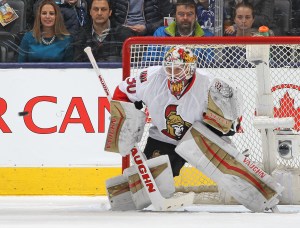
After exhausting the trade market to find a suitor for Andrew Hammond, the Senators placed Andrew Hammond on waivers yesterday signalling perhaps one of the organization’s most precipitous falls from grace since Dany Heatley clashed with Cory Clouston.
About 18-months since Hammond’s Cinderella’esque emergence on the NHL scene concluded, but the Senators saw enough of Hammond during his 2014-15 season in which he posted a 20-1-2 record, a 1.79 goals against average and a .941 save percentage to ink the goaltender to a three-year contract extension that paid him an average of $1.35-million per season.
Just two months into the second year of that contract, the Senators painted themselves into a corner through their misevaluation of how long Craig Anderson would be out of the lineup.
Coach Boucher on Craig Anderson’s availability going forward, “he’ll be here more often than we thought.”
— Daniel Slater (@dslatertv) November 17, 2016
//platform.twitter.com/widgets.js
Thanks to this belief and the situation becoming compounded because of a lower-body injury to Hammond, the Senators felt it was necessary to acquire an experienced goaltender to insulate their minor league prospects.
Now the Senators are faced with a situation wherein Hammond needs to play and re-establish some value, but the Senators have two young goaltenders they want to play regularly and allow to develop at the AHL level.
It never really helped that Hammond balked at the suggestion of a conditioning stint, but given his track record and history that doesn’t even include his gaudy first season’s numbers, he’s proven himself over a larger sample size of games to be a superior alternative to Condon. This coupled with some rumours purporting that the organization was frustrated by Hammond’s health woes and inability to step in for Anderson, put him in poor standing with management.
Whatever the case, Hammond must now report to the minor leagues or the Senators can try to loan him to another AHL team. Mind you, considering how fluid the Anderson situation is and how quickly it can change, it’s entirely possible that Hammond could find himself back with the Senators at some point.
Joining Hammond in Binghamton could be Matt Puempel.
The 24th overall pick from the 2011 NHL Draft has struggled with every opportunity he’s been given at the game’s highest level.
In 52 career games, the 23-year old Puempel tallied four goals and six points.
Renowned for his shot and finishing ability as a prospect, Puempel never demonstrated that touch in the NHL. Some may blame his lack of production on the simplicity of him logging regular minutes with the team’s bottom-six forwards, but Puempel was caught in a shitty spot.
Puempel’s always struggled with his skating and play away from the puck and because of it, he hasn’t garnered the trust of the coaches to log big minutes with the team’s more skilled players. Instead, he’s slogging through minutes with the Senators’ fourth liners. Considering how reliant he is on his linemates to carry the puck and doing the leg work within the defensive and neutral zones, his production rates playing bottom-six minutes were doomed.
Now he’s being mentioned in the same breath as former first round flops like Brian Lee, Jim O’Brien and Curtis Lazar. (Jokes! Lazar’s career point production rates is mildly better than Puempel’s, but Puempel has a better goals per 60 minutes of 5v5 ice time rate.)
It’s weird looking back at Ottawa’s vaunted 2011 draft class and Ottawa’s roster.
Puempel’s failure is just a microcosm of Ottawa’s state, the team has essentially struggled to draft and develop impactful first or second round talents of late.
Hopefully Thomas Chabot and Colin White buck that trend, but the Senators don’t have any significant first or second round talents on their current roster since Erik Karlsson’s 2008 draft year.
That’s a long time for any franchise, let alone a franchise that lacks the kind of financial support that other clubs enjoy.
If the Senators are going to change their fate, they need to do a better job of cultivating and developing their high end prospects. It’s one thing to develop a number of players who play NHL games, it’s another to develop players who can step into the lineup and be productive players, especially in an era where it’s easy to find quality roster filler via free agency as the offseason drags into the dog days of August and September.
(As an aside, thanks to a few separate deals, the team no longer has its three first round picks or it its second or third rounders. The only prospects left to show from that draft are Jean-Gabriel Pageau [4th round] and Ryan Dzingel [7th round].)
Add The Sports Daily to your Google News Feed!